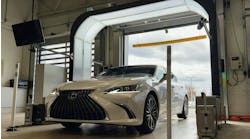Almost all new cars and light trucks have throttle-by-wire. Some have brake-by-wire, and on dual-clutch "manual" transmissions, the clutch and shift mechanism are by-wire. (See Motor Age, October 2005, Teardown). Although these mission critical functions are given top priority in the control unit or Controller Area Network (CAN) that runs them, the driver's control inputs to a by-wire system are not commands; they are requests. The computer decides if and how the request will be executed.
For example, the Powertrain Control Module (PCM) interprets the signal from the Accelerator Pedal Position (APP) sensor as a request for torque. The PCM might operate the throttle actuator until engine torque matches the torque request, or it might unlock the torque converter clutch, adjust ignition timing or make other adjustments to deliver the requested torque, and the actual throttle opening may be greater or smaller than that requested by the driver. (See Motor Age, July 2004, Teardown.)
Sometimes the non-linear throttle response is noticeable. Because the PCM has access to wheel speed data, it also can reduce torque if it detects drive wheel slip. On most vehicles, the throttle will follow the pedal movement only with the key on, engine off (KOEO). Many by-wire throttles have a dedicated control unit that takes its orders from the PCM, but some are integrated into the PCM.
Electronically controlled brakes were introduced by Mercedes-Benz in 2003 in the Sensotronic Brake System. Some would argue it's not true brake-by-wire because it uses hydraulic pressure to apply the brakes. But like the electronic throttle, there is no mechanical connection between the brake pedal and the service brake hydraulic system; pressing the pedal sends a request to the computer, and the computer makes all the braking decisions.
Hydraulic pressure is generated by a pump and stored in an accumulator. A pedal sensor measures the driver's intentions, and the computer operates a series of valves to send hydraulic pressure to each brake caliper. The braking force at each wheel can be applied independently of the others, a basic requirement of ABS. The computer also can apply the brakes without command from the driver, a basic requirement for stability control, enhanced Adaptive Cruise Control and automated collision avoidance. (See Motor Age, November 2006, Teardown.).
The Sensotronic brake system has an emergency brake consisting of an un-boosted master cylinder connected directly to the brake pedal that operates the front hydraulic brakes. The first all-electric brake system is scheduled for production in Europe in 2008, using an electric wedge-type brake caliper.
Steer-by-wire was introduced by General Motors (GM) in 2002 on the GMC Sierra Denali pickup. Called Quadrasteer, it steers the rear wheels opposite the front to reduce the truck's turning circle at low speeds. At higher speeds they are steered in the same direction as the front to enhance stability, particularly when towing.
Two identical control units operate a motor on the pinion shaft of a rack-and-pinion steering gear, and both must agree in their calculations or the steering rack is locked in the straight-ahead position. There is also an on-off button on the dashboard.
Front-wheel steer-by-wire is possible today, but car manufacturers say their customers aren't ready to give up direct control over steering. BMW took a half-step in 2005 with the introduction of "Active Steering," a computer-controlled variable ratio steering system. The steering shaft connects to a gearbox with an electric motor that drives one of the gears when the steering wheel is turning. During low-speed parking maneuvers, the motor turns in one direction to increase steering ratio, steering the front wheels more than the driver requested. At higher speeds, the motor turns the other way to reduce steering ratio for improved stability. With the motor not turning, steering ratio is fixed.
Front-wheel steer-by-wire is complicated because the driver needs to feel resistance in the steering wheel that is proportional to actual control forces. An emerging technology called "haptics" is being developed along with by-wire controls. Using sensors, actuators and software, it provides tactile feedback through the controls to the driver. For instance, with steer-by-wire, the computer could measure the amount and direction of current drawn by the pinion shaft motor. With the steering wheel also mounted on a motor, the computer could operate that motor to simulate the forces acting on the steering rack motor, exactly like a video game. Although relatively new, the technology is well developed. However, the software is very sophisticated, and a computer crash would also mean a vehicle crash.
There might always be some kind of manual override for emergency brakes and steering, but the total by-wire car is possible now. The only issues are customer acceptance and software reliability. Manufacturers expect both to become non-issues for the next generation of drivers.


